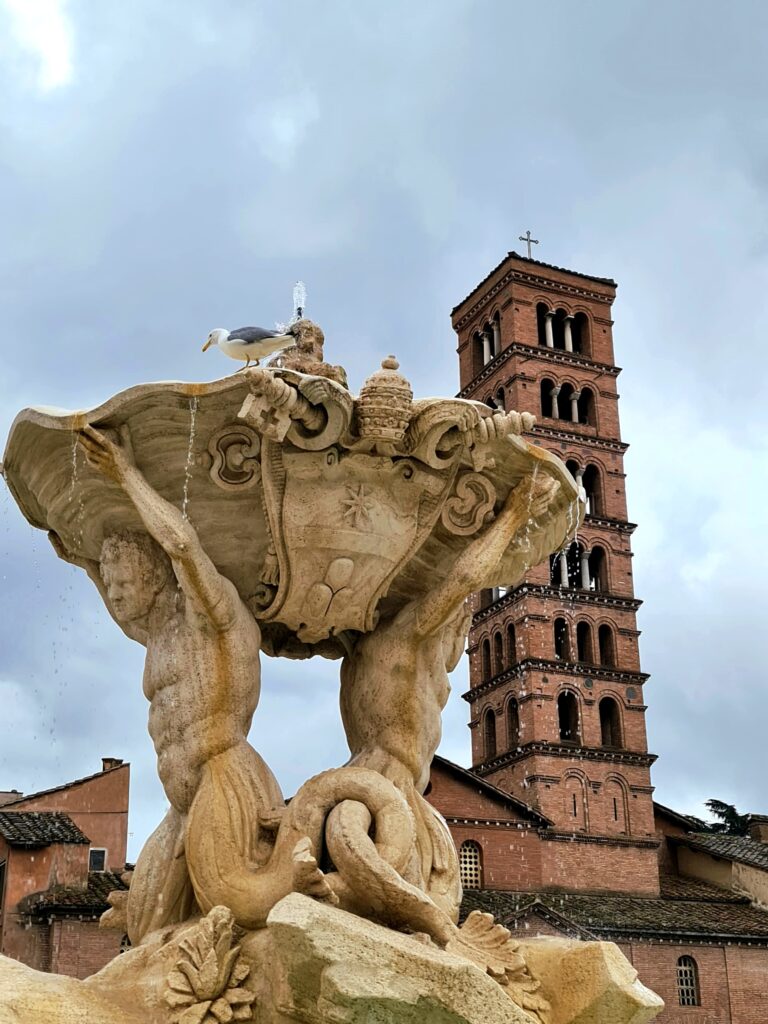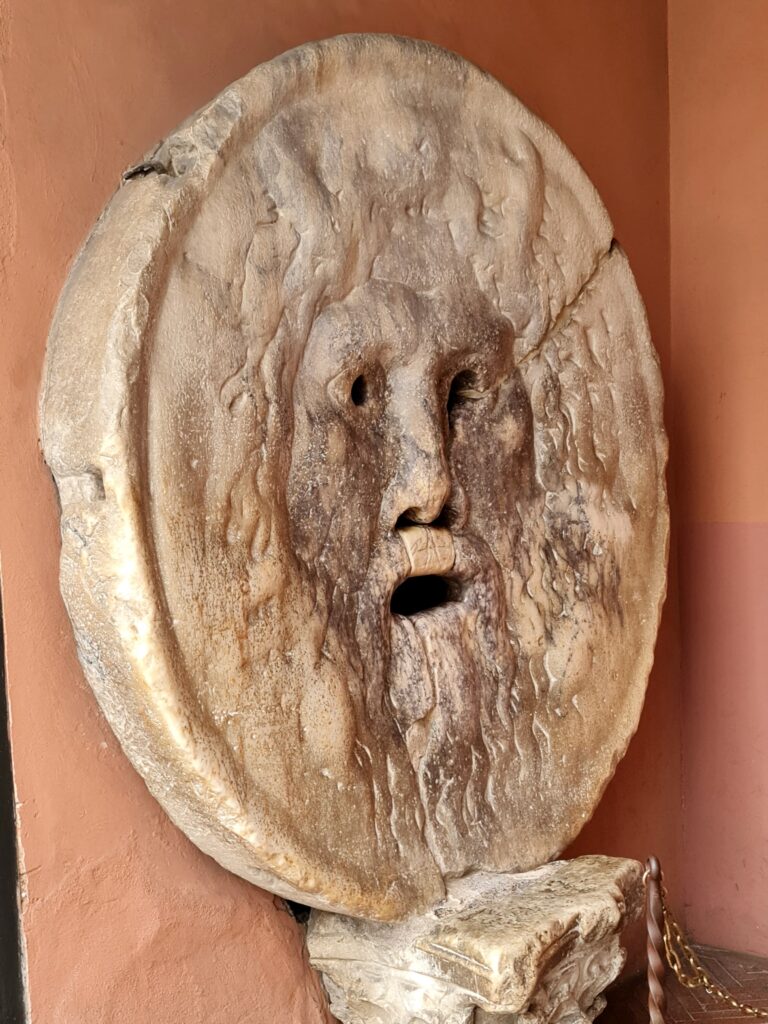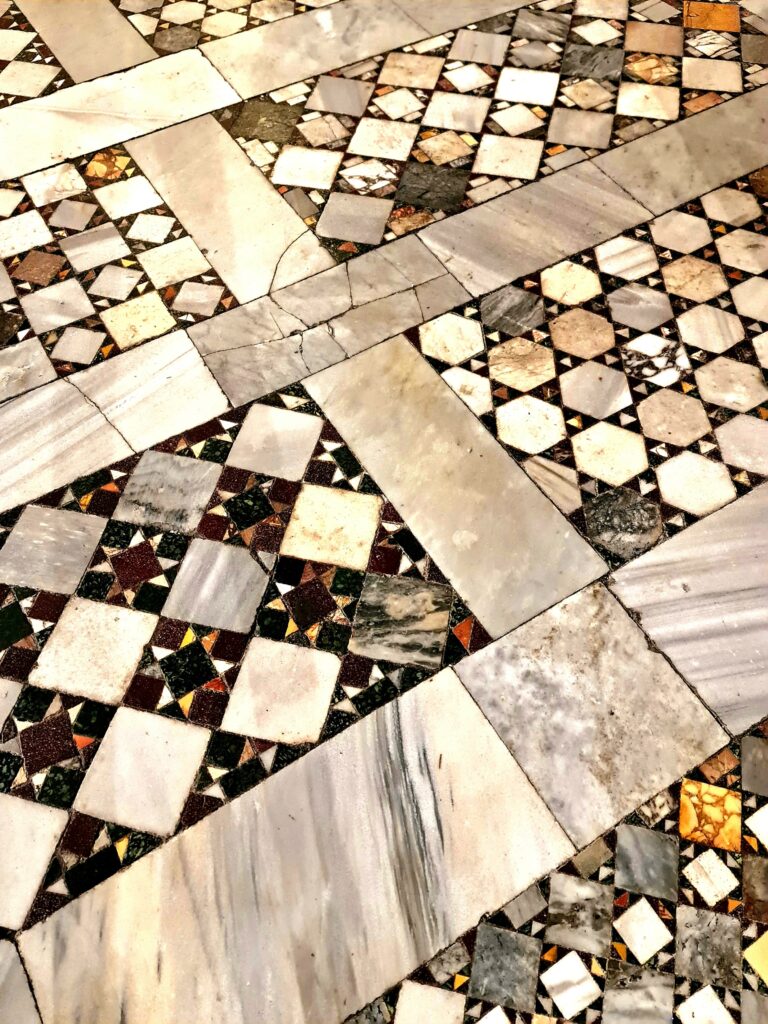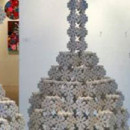In a quiet square in the heart of Rome, just steps from the Tiber River and next to the church of Santa Maria in Cosmedin, stands one of the city’s most curious and fascinating attractions: the Bocca della Verità. Every day, hundreds of visitors line up to take a photo with their hand inside its wide opening, smiling with a mix of amusement and fear. But what lies behind this enigmatic stone mask? What is its history, and why does it continue to exert such a powerful fascination?

A stone mask with a mysterious past
The Bocca della Verità is a large marble disc, about 1.75 meters in diameter, depicting a bearded male face with pierced eyes, nose, and mouth. The work is made of pavonazzetto marble and dates back to imperial Roman times, probably between the 1st century BC and 1st century AD. Its original function is uncertain, but scholars tend to agree that it was a drain cover, a decorative manhole for a cloaca, or perhaps part of a fountain.
Some also speculate that it may have belonged to an altar or sacred fountain dedicated to a river deity, given its symbolic connection to water. The face likely represents, according to the most credited interpretation, a river god, linked to the Tiber or one of the ancient underground waters of Rome. The Romans often personified natural elements, attributing them human features: rivers, winds, mountains, even abstract concepts like Fortune or Concord. A river god with an open mouth could symbolize nature’s power to swallow and return, like water itself. This primordial connection may explain the sense of reverence the Bocca has inspired over the centuries.

In the Middle Ages, the disc was placed in the portico of Santa Maria in Cosmedin, where it can still be admired today. From a simple functional object, it became a mysterious symbol, at the center of tales and legends. Its placement in a religious setting was not accidental: the Middle Ages loved to surround themselves with symbol-laden images, capable of inspiring fear, respect, or reflection. The Bocca thus became a silent warning, a stone sentinel ready to unmask liars.
The legend of the severed hand
According to popular tradition, the Bocca della Verità could recognize liars. Anyone who dared put their hand inside its mouth while telling a lie risked having it cut off. This myth spread especially during the Middle Ages and captured the collective imagination for centuries.
Also interesting is the didactic role the legend took on: the Bocca became a symbolic educational tool, a moral deterrent against lying, especially for the young. Tales like this served to transmit values through fear and respect for perceived higher powers.
A symbol made famous by cinema
In the 20th century, the Bocca della Verità enjoyed a new wave of popularity thanks to cinema. It became world-famous with the 1953 film Roman Holiday, starring Audrey Hepburn and Gregory Peck. In one of the film’s most iconic scenes, the two protagonists stop in front of the Bocca, and Gregory Peck pretends to lose his hand, frightening Hepburn and drawing a laugh from the audience. The scene was improvised by the actor, and Hepburn’s reaction was genuine.
This moment helped make the Bocca an internationally recognized image and an essential stop for tourists visiting Rome. After the film’s release, the number of visitors rose sharply, and since then the Bocca has become a true emblem of the city, often seen on postcards, souvenirs, and promotional material.
Listen to our podcast to learn more about other iconic places in Italy!
It’s not an isolated case: other monuments also benefited from this “cinematic effect.” The Spanish Steps and the Trevi Fountain owe much of their global fame to the seventh art. In the Bocca’s case, however, it was a true rediscovery: a fragment of archaeology that, ironically, became famous due to a fake lie that exposes fiction itself.
Around the Bocca: a Roman itinerary
Those who visit the Bocca della Verità also have the chance to explore one of the most fascinating areas of Rome. Right next to it stands the church of Santa Maria in Cosmedin, built in the 8th century and enriched over time with medieval and Byzantine elements. Inside, visitors can admire beautiful mosaics, a Cosmatesque floor, and a quiet atmosphere that invites reflection.

Just steps away lies the Forum Boarium, the ancient Roman cattle market, where stand the Temple of Hercules Victorand the Temple of Portunus. The former, with a circular plan, is one of the best-preserved sacred buildings of ancient Rome and captivates with its essential elegance. The latter, rectangular and harmonious, tells the story of the city’s commercial and religious life.
Not far off is the Circus Maximus, a vast space that once hosted chariot races, capable of holding up to 250,000 spectators. A place that, like the Bocca, has crossed the millennia, retaining its charm intact.
A truth that concerns us
Perhaps the secret of the Bocca della Verità’s appeal lies precisely here: in its silence. It does not shout, does not judge, does not impose. It’s been there, immobile, for centuries, and leaves everyone the freedom to reflect. Truth, after all, is also a personal matter. Sometimes, a stone gaze is enough to remind us of that.
And maybe, next time you pass by and slip your hand into the Bocca della Verità, try thinking of a truth you’ve never spoken. Not out of fear of being punished, but for the simple pleasure, or relief, of finally acknowledging it.
Want to learn Italian in Rome? Check out our school!
Scuola Leonardo da Vinci Rome
The Eternal City has known it all. Victory and defeat, joy and tragedy, glory and humility marked Rome’s history, culture and architecture. A magical place with vibrant, timeless lifestyle with countless secrets waiting to be discovered.
The Scuola Leonardo da Vinci is situated in the centre of Rome, in the pedestrian area, halfway from the astounding Piazza Navona, Castel S. Angelo and St. Peter Basilica. It is one of the largest schools in Rome.
We, from Leonardo da Vinci School have one mission – to introduce you to this exciting urban symphony. Every year thousand of students from more than 90 countries jump into this adventure hand in hand with us. Leonardo da Vinci School is not only leading language institute, but centre of Italian culture and lifestyle. We match our vast experience with our student’ eagerness to know and learn and together we make it happen.
Latest posts by Scuola Leonardo da Vinci Rome (see all)
- Living and learning Italian in Rome: the guide for international students - September 26, 2025
- ROME: DISCOVERING THE MAXXI - August 5, 2025
- PASQUINO: THE STATUE THAT MAKES ROME SPEAK - July 18, 2025









